LACMA docents mark 50 artful years
May 8, 2012
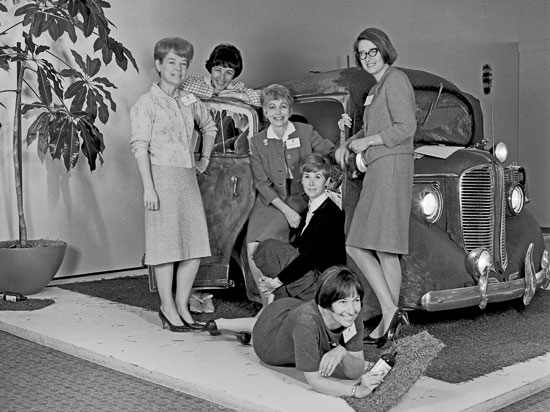
Terry Bell, second from left, and fellow docents defended Kienholz's "Back Seat Dodge '38" in LACMA's early years.
Terry Bell was a 34-year-old homemaker with two children in Westwood when art changed her life.
“It was the early ‘60s, and I had a good friend who did fundraising for the museum,” she remembers. “One day she said, ‘You’re a disgrace! You’re a college graduate and you don’t know anything about painting or sculpture.’ ”
At her friend’s insistence, she signed up for a then-new program to train docents at the Los Angeles Museum of History, Science and Art in Exposition Park, which at the time housed the county’s art collection. Now, 50 years later, she is an avid art collector, a Los Angeles County Museum of Art life trustee and a founding member of one of the largest docent organizations in the nation. She has exposed thousands of visitors to museum treasures, recorded acoustic guides for major exhibitions and worked against the censorship of controversial and important artworks.
And she traces it all to that decision a half-century ago to volunteer as a LACMA docent..
“It is just so rewarding,” says Bell, who this week is among the hundreds of honorees celebrating the golden anniversary of LACMA’s Docent Council. “Not only in terms of yourself, but in what you can give back to the community.”
Some 521 men and women belong to the Docent Council, a volunteer juggernaut whose members have led more than 2 million children and adults through the museum since it became an official entity in 1962.
More than a million Southern California schoolchildren have been led on field trips by LACMA docents; so have generations of adult visitors to the museum’s many exhibitions.
“We are definitely in the front lines,” says Judith Tuch, who chairs the council. “We provide the personal connection between the students and adults who come to the museum and the art they see. For many, it’s the first time they’ve ever been in a museum. For some, unfortunately, it may be the only time they’ll be in a museum.
“We encourage them to understand that this is a county museum, and that this is their place.”
The council grew from a small group of volunteers who explained art during the 1950s at what is now the Natural History Museum. Though visitors at that Exposition Park site mostly came to see dinosaurs and fossils, the county also had quietly been amassing fine art since the 1920s. Members of the Junior League, the Volunteer League of the San Fernando Valley and other local organizations offered informal tours of the gifts from such early donors as William Preston Harrison, Paul Rodman Mabury and William Randolph Hearst.
In 1961, amid planning for a separate Los Angeles County Museum of Art on Wilshire Boulevard, the groups joined forces to create a formal docent training program. Fifty-three women took the special classes in art history and elementary education.
After a provisional year, the Docent Council was officially formed, chaired by Glenn Cooper, a Junior Leaguer who later became a well-known arts patron in Sun Valley. Their goal: To train 200 docents in time for the official opening of LACMA in 1965.
The docents were key almost from the moment the new museum opened. In 1966, for instance, they rose to defend Edward Kienholz’s still-controversial “Back Seat Dodge ’38.” The piece, which depicts a beer-soaked encounter in a parked car, is so sexually charged that members of the then-Board of Supervisors denounced it as pornographic.
“I had met Ed Kienholz and talked to him about the exhibition, and I thought it was terrific,” Bell remembers.
 Eventually, the Supervisors decided the piece could be seen, “but the door to the car couldn’t be open unless a docent was there to explain it,” Bell says, recalling that at one point, she had to tour a group of clergy that included her own rabbi—whom she had to shush with the admonition that she listened to him every week, so he should do her the courtesy of returning the favor.
Eventually, the Supervisors decided the piece could be seen, “but the door to the car couldn’t be open unless a docent was there to explain it,” Bell says, recalling that at one point, she had to tour a group of clergy that included her own rabbi—whom she had to shush with the admonition that she listened to him every week, so he should do her the courtesy of returning the favor.
The piece—like later Kienholz exhibitions that Bell also guided—became a sensation and visitors mobbed the museum. “Five or six of us guided tours every 20 minutes,” Bell remembers, “almost around the clock.”
Since then, the council has grown along with the county in diversity and sophistication. Some 25 members are men and docents of all races, creeds, ages and backgrounds lead tours in multiple languages.
Now overseen by the museum’s Education Department, the group has a training regimen that includes extensive coursework in art history and touring techniques and a 2-year provisional period. No member can tour adults without spending at least 5 years doing school tours.
“We have several attorneys in the current [provisional] class,” says Patsy Palmer, a child psychotherapist and longtime LACMA volunteer who now trains incoming docents. “One man in my group is a retired doctor.” All the new docents, she says, “are highly qualified and uniquely skilled.”
“We’ve come so far,” agrees Bell, who says she can’t wait to see how visitors respond to “Levitated Mass” and other upcoming attractions. “We’re really in a marvelous place.”
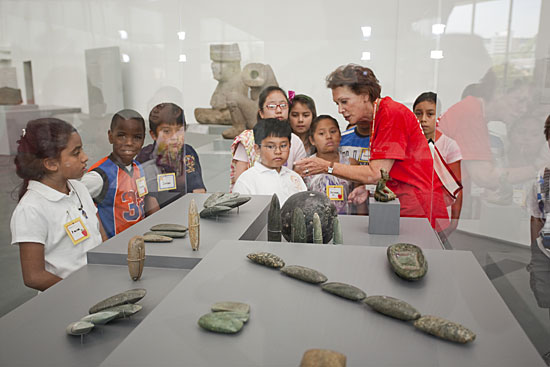
LACMA docent Patsy Palmer has shown the museum to legions of children. The Docent Council turns 50 this week.
Posted 5/2/12
Way to go, Hollywood Bowl
May 7, 2012
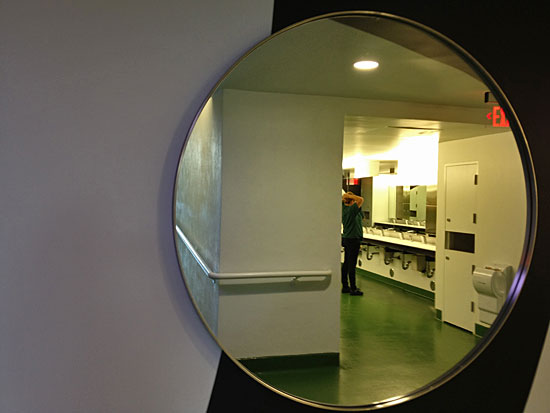
Glossy green floors, dramatic mirrors, Dyson hand dryers and LED lighting are all part of the re-do.
With legendary headliners ranging from Glen Campbell to Smokey Robinson to Plácido Domingo on the 2012 bill, it’s not easy for a newcomer to break through at the Hollywood Bowl.
But it’s a safe bet that the new restrooms designed by Rios Clementi Hale Studios will have audiences cheering when they make their Bowl debut this summer.
With sustainable features like Dyson hand dryers, LED lighting, water-saving fixtures, graphics inspired by the Bowl’s Art Deco architecture, and glossy green floors intended to bring the outdoors in, the restrooms represent a stark departure from the old, dark spaces that used to make intermission such a drab interlude.
[Updated 9/20/12: The Bowl’s bathroom re-do is a finalist in the America's Best Restroom contest sponsored by Cintas. Cast your vote here.]
The Bowl is a Los Angeles County park—albeit one with a worldwide reputation for glamour, fireworks and star-studded concerts—and the $3 million makeover was funded by Proposition A park improvement funds.
The bathrooms also feature reengineered layouts, dramatic mirrors, new privacy partitions between urinals and lighting accents to make sure patrons keep moving toward unoccupied facilities in the back, rather than creating unnecessary bottlenecks at the front of the line.
The new facilities were unveiled Monday evening at a Bowl reception along with some less noticeable but equally important off-season improvements like $600,000 in concrete repairs, including the replacement of a stairway built in 1954. Also underway, and expected to be finished in coming weeks, is the $2 million replacement of the moving sidewalk (also known as a speed ramp) that helps 75% of Bowl patrons get up the hill to their seats.
If you’d like to test drive the new and improved Bowl—and listen to some world-class music while you’re at it—tickets are on sale now. The season gets off to a big start June 22, with opening night festivities hosted by Julie Andrews and featuring Reba McIntyre, Chaka Khan and the Hollywood Bowl Orchestra conducted by Thomas Wilkins.
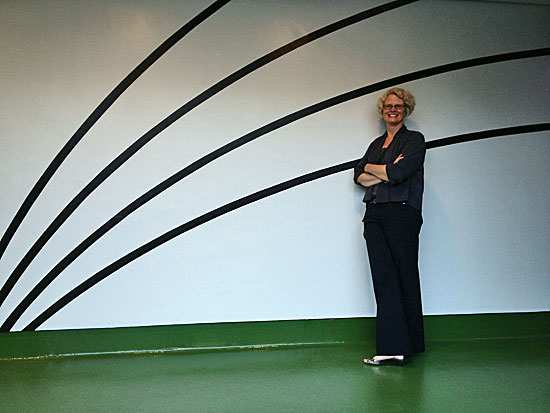
Julie Smith-Clementi of Rios Clementi Hale, outside one of the Bowl bathrooms redesigned by her firm.
Posted 5/7/12
Seniority has its privileges
May 3, 2012
This month, it pays to be a senior—whether you walk on two legs or four.
The county’s Department of Animal Care and Control’s new promotion is called Super Senior May: Never Too Old to Play. Throughout the month, people over 60 will have their pet adoption fees waived at county shelters.
And everyone, regardless of age, will get discounted fees when they adopt any pet that is five years old or more.
Check out the department’s Facebook page for more information, and see whether you can find “puppy love” all over again with an older pet.
Posted 5/3/12
Ah, to be young and in tune
May 3, 2012
More than 900 young vocalists from 25 area high schools are about to see first-hand that, yes, believe it or not, a career in music is possible.
On Friday, May 5, the 23rd Annual High School Choir Festival will bring students from all parts of the county to Walt Disney Concert Hall for a chance to sing under the baton of Grant Gershon, Music Director of the Los Angeles Master Chorale. By getting top-notch pros involved with the young singers’ preparation, the Grammy-nominated Chorale hopes to foster a lifelong appreciation for the arts while encouraging aspiring musicians.
“Being able to work with the chamber singers they see that level of experience, the life of a professional singer,” said Lesili Beard, education programs manager for the Chorale. “There are professionals in the Master Chorale now who once participated in the high school chorus.”
Friday’s festival is free to the public, but tickets are required, and will be available on a first-come, first-served basis starting at 9 a.m. in the Walt Disney Concert Hall lobby.
About a year ago, individual choir programs were vetted for participation. Program size, past participation and representation of the diverse communities of Los Angeles County were all factors considered. For the chosen programs, the event becomes one of the year’s highlights.
“As a choir director, it gives my program incentive,” said Marsha Lynne Taylor, director of the Grant High School Vocal Ensemble in Van Nuys. “If you can imagine some of the kids never going to a music hall, never going to a concert… and here they find themselves performing at the Disney Hall.”
The students don’t come unprepared. After the selection process, Gershon met with choir directors to go over the musical selections and offer his personal edits and instructions. After that came numerous practices and rehearsals, assisted by members of the Chorale. Finally, the Chorale held two large rehearsals with about 450 students each (“to make sure the young performers don’t go into shock,” joked Beard).
At 11 a.m. on the day of the event, student singers and their audience will watch a complimentary performance by the Master Chorale and hear a demonstration of the Disney Hall’s massive concert organ.
At 1 p.m., the student program will begin, presenting songs spanning multiple languages and styles. The show will conclude with a rendition of Joseph Haydn’s The Heavens Are Telling, sung in unison by the full group.
The end result is surprisingly crisp, said Tom Pease, director of the William Howard Taft High School Vocal Ensemble in Woodland Hills, whose choirs have participated in the event for about the past 15 years.
“The kids are well-rehearsed and [Gershon] does a really great job of keeping them together” said Pease. “What you end up with is a really powerful, rich, full sound.”
Posted 5/3/12
E-stockpile found at assessor’s office
May 3, 2012
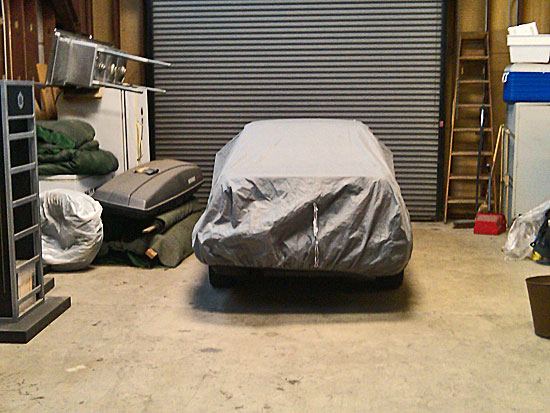
Assessor's equipment shared space in this storage facility with the landlord's car, bikes and mattresses.
As Los Angeles County was tightening its belt in recent years, its assessor’s office was sitting on a cache of more than a half-million dollars’ worth of brand-new electronics equipment it had stockpiled but never used, a newly-released county audit found.
The auditors discovered some $654,000 worth of never-used equipment, ranging from laptops to laser jet printers, languishing in storage at the Hall of Administration after it was purchased between fiscal years 2001-2 and 2009-10.
“A lot of the equipment was still brand-new, still sealed with the original vendor tape,” said David Aldava, an intermediate accountant-auditor who was part of the team that looked into technology in the assessor’s office.
Aldava’s team also made another unusual discovery: The department had improperly stashed pallets loaded with other computers, printers and tech equipment—some still functioning, some headed to the junk pile—in an unlocked, leased storage facility in Signal Hill, where the county-owned equipment shared space with the landlord’s car, bicycles, refrigerators, mattresses and even a bar sign or two.
The equipment ended up in the storage facility—next to the assessor’s South District office—after employees initially told auditors that the department had no surplus electronics. Eventually, though, the staff “told us that they had previously moved the surplus items from other locations to the storage building in an attempt to hide the equipment from us,” according to an April 13 report from Auditor-Controller Wendy Watanabe.
In a response to the audit filed last month, the department concurred with virtually all of the auditor’s 25 recommendations, most aimed at tightening accountability, record-keeping and security and ensuring that IT equipment is purchased only when needed.
Assessor’s spokesman Louis Reyes said the office is “fully cooperating” in correcting problems uncovered in the audit. “The assessor wants to address these concerns fully,” he said.
Assessor John R. Noguez was elected in November, 2010, and was not in charge during the period in which the new equipment was stockpiled, Reyes noted.
The audit comes as a separate, broader review, ordered by the Board of Supervisors, is underway to examine how the assessor’s office operates across the board. The office has come under fire for allegedly granting preferential treatment to some property owners. Noguez also shocked the supervisors recently when he disclosed a large, unprecedented disparity in property tax projections that could leave the county with a $50 million hole in its budget.
The technology audit, conducted last year and provided to the Board of Supervisors last month, offered its own set of unexpected discoveries.
“This warehouse issue really took us by surprise,” Watanabe said—especially when employees initially refused to let the auditors into the Signal Hill facility, claiming it would take a month to reach the landlord and get his permission for access. “That really piqued our interest.”
It turned out that an effort was underway, apparently, to thwart auditors from discovering an abundance of surplus equipment, which is not allowed under county policy. “They started to dump everything to Signal Hill…We finally did get in and saw stacks and stacks of used computers,” Watanabe said. “They didn’t want us to see it, to cover up that they’d initially lied.”
Even as the used computer equipment was piling up, the department was also acquiring the stacks of new and unneeded electronics—apparently part of a use-it-or-lose strategy of spending IT funds at the end of fiscal years rather than allowing unspent money to revert to the Chief Executive Office’s overall county budget, the audit found.
Beyond the cost of the equipment itself, the department overpaid by not waiting to buy the items until they were actually needed. Because technology prices tend to decrease over time, the assessor’s office ended up paying at least $93,000 more than it should have, the audit found.
Despite the huge build-up in excess tech equipment being stored, the assessor’s office still had plenty of electronic devices to go around, it appears. The audit found that 324 of the department’s 1,425 employees had at least two computers assigned to them—and 57 had three or more.
“To us, this is just ridiculous,” Watanabe said. “There’s really no business reason to justify why someone would have three or more computers.”
The employees themselves admitted as much to county auditors when asked about those second or third computers.
“Oh, yeah, it’s just sitting in my trunk,” some said when questioned about laptops they’d been issued, according to Watanabe.
Having an unused laptop lying around the house or car has hidden costs, too, Watanabe said, since the county pays virtual network fees of $600 a year for each employee who logs onto the network from outside the office—whether a device is being used or not.
Then there were security lapses. The audit said that the assessor’s department disposed of some surplus equipment without first erasing county information from the devices’ hard drives. It also found that 22% of the department’s computers didn’t have any working anti-virus protection.
Although Watanabe said no fraud was uncovered, the audit found a system of lax controls and a cavalier attitude toward safeguarding county property.
As for the surplus devices stashed in Signal Hill, those have all been junked or donated since the audit, or will be soon, according to the department. And employees in the assessor’s office have begun working their way through that unused stockpile of new equipment.
Posted /3/12
Expo Line’s festive and historic debut
May 2, 2012

The Expo Line rolled into the record books, as the initial phase of the light rail was formally opened on Friday, April 27.
It will run at first between downtown Los Angeles and the La Cienega/Jefferson station, with an opening of the line’s Culver City station planned in coming weeks. The 8.6-mile line was inaugurated with a flourish—complete with tunes from the USC Marching Band, the appearance of huggable T-Rex from the county Natural History Museum, confetti cannons and free rides during Expo’s opening weekend.
Dignitaries including Supervisor Zev Yaroslavsky, chair of the Expo Board, celebrated the historic nature of the occasion, as the first light rail trains since the Red Car made tracks for the Westside. A second phase of the line, which will run to Santa Monica, is now underway.
Posted 5/2/12




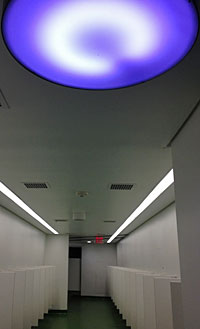

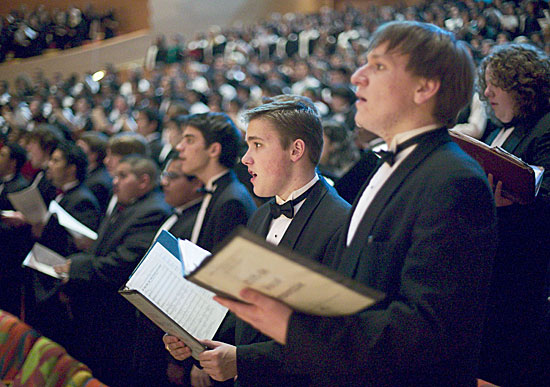
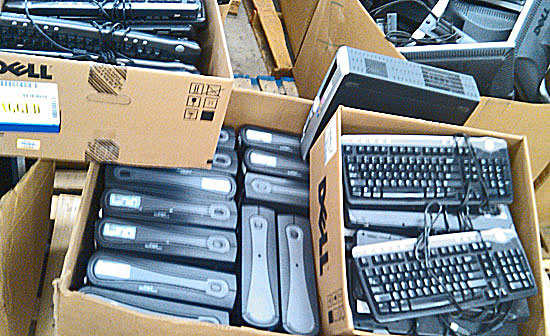





 Check for the latest closure information
Check for the latest closure information








